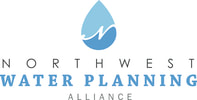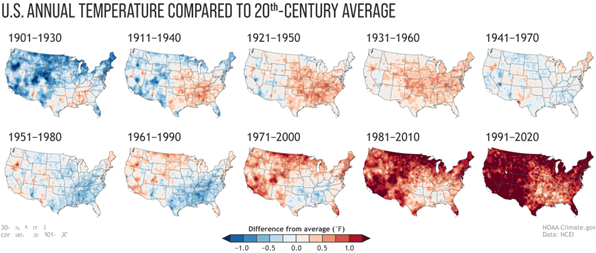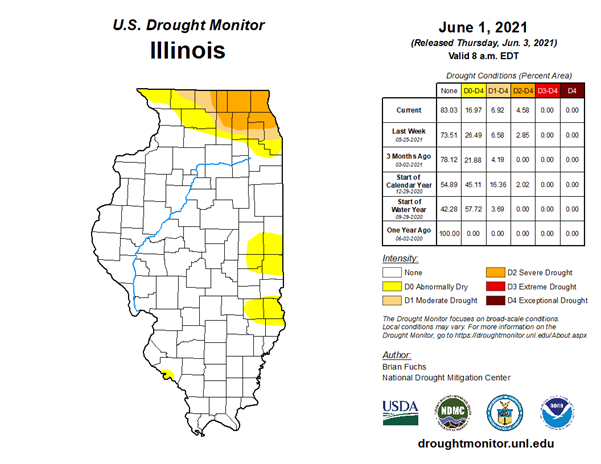|
Drought on the Horizon Last month the National Oceanic and Atmospheric Administration (NOAA) released its latest Climate Normals – a decennial analysis of U.S. weather over three decades (1991 – 2020). This snapshot provides a more accurate reflection of what is considered ‘normal’ weather amid a rapidly changing climate. According to NOAA, the average annual temperature in Illinois has increased by about 1 degree Fahrenheit since the beginning of the 20th century. By the end of this century, temperatures are expected to rise 7 to 12 degrees. Climatic shifts associated with a warming atmosphere have led to clear changes in the frequency and intensity of certain weather events. In 2020, Chicago experienced its hottest summer and wettest May on record. Yet May 2021 marked the region’s fourth consecutive month of below average precipitation, leaving many Northwest Water Planning Alliance (NWPA) communities experiencing moderate and severe drought – conditions that are expected to linger and potentially expand through the summer. While dry weather may have been a welcoming relief after two years of abnormally wet springs, it poses drinking water supply challenges for river- and shallow groundwater-dependent communities within the NWPA region. What does this mean as we head into summer? For river-dependent communities, drought contributes to reduced surface water flows and algae growth. These are conditions emerging in the Fox River with algae becoming the greatest threat as temperatures rise. According to the City of Aurora, a major river-dependent community, certain types of algae clog water treatment filters making the process more difficult and expensive. Albeit safe to drink, algae can even cause treated water to taste and smell unpleasant. For shallow groundwater-dependent communities, drought means less precipitation to replenish aquifers. Recently, the Sugar Grove Water Authority sampled local shallow aquifers and found that the groundwater was at least one foot below its typical level, highlighting the lack of recharge occurring in the area. Dried soils can also increase runoff and exacerbate recharge and water quality challenges. Aquifer drawdown that exceeds its recharge rate can impact nearby surface waters dependent on groundwater flows and result in neighboring wells competing for less water as well. Summer heat will amplify the drought-induced stress placed on water supply. Temperatures are historical higher and the demand for water rises in May and peaks in July. Approximately thirty percent of the region’s residential water use is dedicated to outdoor watering, and as much as fifty percent of it is wasted due to watering inefficiencies. Drought aside, summer use can strain resources and infrastructure, cause peak usage to rise, and increase the need for costly infrastructure upgrades. What can you do? Outdoor water conservation and education After a difficult drought in 2012, the NWPA focused on lawn watering practices to reduce outdoor water use and peak demand. These efforts led to a lawn watering ordinance developed in collaboration with regional partners. The ordinance applies year-round, places time limitations on outdoor watering, bans the “watering” of sidewalks, favors efficient watering devices like drip irrigation, and includes provisions for reduced use and prohibition during drought conditions. Widespread ordinance adoption will help communities manage their water supply even in a drought. Check your municipality’s outdoor water use guidelines to see if the ordinance has been adopted. If not, advocate for its adoption! Share educational materials about the ordinance and talk about the importance of water conservation with local officials and residents. Aurora found that its water conservation ordinance helped reduce enough peak daily demand to delay and downsize water infrastructure, resulting in an $8 million savings. They also are able to keep water rates low without the need to pay for costly capital improvements.
Drought monitoring and planning Municipalities should closely monitor drought conditions to help guide water conservation measures and operations. Communities can also develop a municipal drought action plan. Both the American Water Works Association and U.S. Drought Portal provide guidance on drought planning and preparedness. Review latest climate assessment for Illinois NWPA communities should stay updated on the region’s climate impacts. The latest and first statewide climate assessment projects that climate change will continue to increase the frequency of drought conditions and the magnitude of shortages in surface water supplies as well as threaten the viability of groundwater water supplies. Comments are closed.
|
ABOUTThe latest updates page features posts about issues affecting NWPA member communities and best practices, drawing on interviews and conversations with experts. Archives
July 2024
Categories
All
|



